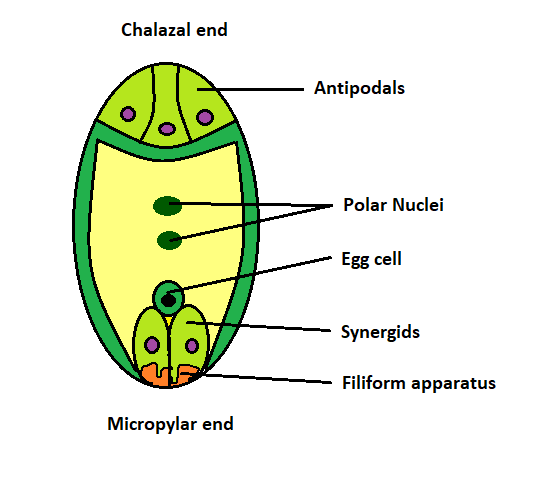
Answer
456.3k+ views
Hint: In an embryo sac, there are synergids, an egg cell, antipodal cells and two polar nuclei are present. The two polar nuclei are present at the center of the embryo sac and its ploidy is (n+n).
Complete answer:Synergids – They are also known as the helper cells or the Co-operative cells. They are present in the micropylar end. They are two in number. These cells have a micropylar nucleus and a chalazal vacuole. They lack a cell wall at their micropylar end due to the presence of the filiform apparatus.
Antipodals – They are the vegetative cells of the embryo sac. They are three in number. They are present towards the chalazal end.

Thus, the number of synergids and antipodals present in a typical angiosperm embryo sac at maturity are two and three respectively.
Hence, the correct answer is option (A).
Additional Information: The embryo sac consists of the following type of cells –
1. Central cell – It is the largest cell in the embryo sac. It contains two polar nuclei. These two nuclei fuse just before the fertilization to form the secondary nucleus or the definitive nucleus.
2. Egg cell – It is found at the micropylar end along with the synergids. Its cytoplasmic polarity is opposite to that of the synergid. The wall of the egg cell is thicker at the micropylar end. It has a micropylar vacuole and the chalazal nucleus.
3. Synergids
4. Antipodals
Note: The synergids and the Antipodal cells degenerate after the process of fertilization. The synergid degenerates as soon as the pollen-pistil interaction is activated, and the pollen tube reaches and touches the wall of the embryo sac. When the synergid is destroyed then two black spots are formed known as the X-bodies. The two X-bodies are from the nucleus of one synergid and nucleus of one pollen tube respectively.
Complete answer:Synergids – They are also known as the helper cells or the Co-operative cells. They are present in the micropylar end. They are two in number. These cells have a micropylar nucleus and a chalazal vacuole. They lack a cell wall at their micropylar end due to the presence of the filiform apparatus.
Antipodals – They are the vegetative cells of the embryo sac. They are three in number. They are present towards the chalazal end.

Thus, the number of synergids and antipodals present in a typical angiosperm embryo sac at maturity are two and three respectively.
Hence, the correct answer is option (A).
Additional Information: The embryo sac consists of the following type of cells –
1. Central cell – It is the largest cell in the embryo sac. It contains two polar nuclei. These two nuclei fuse just before the fertilization to form the secondary nucleus or the definitive nucleus.
2. Egg cell – It is found at the micropylar end along with the synergids. Its cytoplasmic polarity is opposite to that of the synergid. The wall of the egg cell is thicker at the micropylar end. It has a micropylar vacuole and the chalazal nucleus.
3. Synergids
4. Antipodals
Note: The synergids and the Antipodal cells degenerate after the process of fertilization. The synergid degenerates as soon as the pollen-pistil interaction is activated, and the pollen tube reaches and touches the wall of the embryo sac. When the synergid is destroyed then two black spots are formed known as the X-bodies. The two X-bodies are from the nucleus of one synergid and nucleus of one pollen tube respectively.
Recently Updated Pages
How is abiogenesis theory disproved experimentally class 12 biology CBSE

What is Biological Magnification

Fill in the blanks with suitable prepositions Break class 10 english CBSE

Fill in the blanks with suitable articles Tribune is class 10 english CBSE

Rearrange the following words and phrases to form a class 10 english CBSE

Select the opposite of the given word Permit aGive class 10 english CBSE

Trending doubts
Which are the Top 10 Largest Countries of the World?

What is the definite integral of zero a constant b class 12 maths CBSE

What are the major means of transport Explain each class 12 social science CBSE

Differentiate between homogeneous and heterogeneous class 12 chemistry CBSE

Explain sex determination in humans with the help of class 12 biology CBSE

How much time does it take to bleed after eating p class 12 biology CBSE




